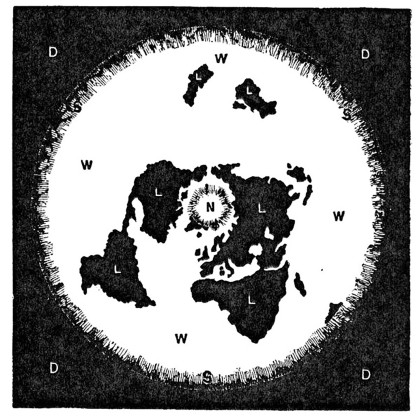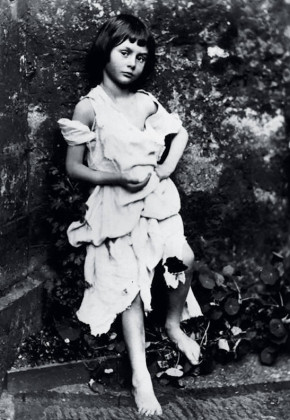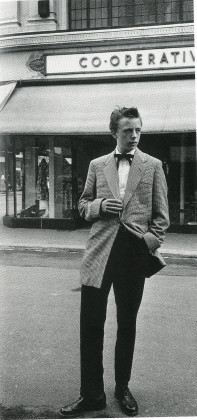Conscience Fiction
After long debates and intensive research, for 2016 as the word of the year The Oxford Dictionary had chosen post-truth1, the condition that objective facts are not as effective as feelings and personal opinions in manufacturing public opinion about a particular issue. This is basically the globalized version of what Flat Earth Society2 has been doing for nearly 300 years. But this article is not particularly about this word.
The serious questioning of truth or the announcement of its end has been done by various philosophers, naturally and inevitably. In his book "A Thousand Years of Nonlinear History" Manuel De Landa altered the image of history from being a bicycle to a carousel -carousels that are intertwined and spinning towards different directions in 3D).3 Long before that, at the beginning of 1980s, Jean Baudrillard4 was arguing "Symbols and images have replaced what used to be real and concrete, that’s why we are living in virtual reality." In the second stage of his four-stage theory, signs begin to garnish, exaggerate and distort the truth, but we are still attached to reality. In the third and fourth stages, though, signs and simulation replace reality, and we slide into a symbolic society. Even long before this, in the 1970s, Marshall Bermann was announcing a future where concepts were stripped of their meaning through the melting of all that is solid into air; a grim, unsustainable future focused on progress, development and growth. Long story short, we have been incrementally eliminating objectivity, knowability and reality since the mid 20th century. Maybe the term "post-truth" is just the only and the very popular neology for it. Besides, as the press secretary of the president of the USA declared in 2017, there is no such thing as a lie -hence truth or fact- anymore; instead, there are alternative facts.5 I should also note that the concept does not refer to an agnostic or sceptical approach to reality but an untethered manipulative subjectivity of argumentation.
A common misconception in today’s design and architecture projects is the notion that societies, social structures, cities and other things have always been this way. There always was the meter as a measurement unit; nuclear family always consisted of four people, the table was the table all along6, so was the chair. The conventions and archetypes are so strictly defined today that it is impossible to manifest or even propose to manifest them in any other way. Therefore, the justification of design-related decisions frequently draws a vicious circle: Why is it this way? Because it has always been this way.
Concepts that we consider the most objective are actually reflections of things that have been invented somewhere along with the social flow or things that were first named then defined. And these “things” of humanity have not always been “this way”. Moreover, our relationship with these “things” has also been continuously changing and transforming.7 The “things” in this sentence, which may sound innocent or obvious when stated this way, actually covers almost every “thing”8: family, children, youth, furniture, kitchen, teacup, paper roll, house, office, street, complaint, nationalism, nation, ideology and even consciousness. For each and every concept, there’s such a point in time, where that concept fails to define what it defines, represents today.
Let’s brainstorm by imagining a family in its generic form: Let this be a nuclear family. How many people are there? Mother, father and kids? Four? Five? Six? Numbers are unimportant. It’s the evening. What time is it? The father has just come home. What is his occupation? Journalist? Miner? Merchant? Running towards the door, the son throws his wheeled horse aside, the daughter her doll. A modern looking mother who has been setting the table on the beautiful four-legged round dinner table passes the cuckoo clock on the wall and joins them.
How far back to the past can we roughly project this contemporary family portrait that’s not very hard to imagine today with details that may vary? 100 years? 200 years? For instance, can we imagine such a setting in İstanbul in the 1850s?
The trigger of the fiction above is the illustration in the book Altun Anahtar, Altun Kitaba Medhal (Golden Key, Introduction to the Golden Book) written by Merchant İbrahim Hilmi in 1916-7. An illustration from just a hundred years ago. Even this, is not the existing but the imagined or the supposed family format of those days. It’s possible to read from various sources that such a family dinner has not occurred even in the modern houses of big cities a few decades later than those times, let alone in the early 20th century.9
Is it possible to imagine the family that’s having dinner in a living room10 that is TV-oriented older than 40-50 years? We should mention families with very different values, and habits existed before the widely spread narration of the popular magazines that shaped the social life and its function in Turkey after World War II. TV aside, the idea of a family having dinner with all its members present at a table barely goes back to 100-150 years.11 Before that, it is something so fundementally different with divergent individualities, roles and rituals, that even calling it “old style family” means the extending of the borders of the concept.
Now let’s look at the child in this image of the family having dinner at a table. The general definition of the child today is a person who is unfettered from adult duties and responsibilities, plays with objects, called toys which are designed specifically for her age, manufactured serially. The child is someone between the ages of roughly 5-14 who goes to school and whose parents love and take care of her deeply and protect her for life. So, within this equation, what will we call these little people who are employed at various jobs all day, who don’t have a room of their own and who don’t have toys that would help them grow physically and mentally, who cannot solve the basic arithmetical equations, who don’t know their age and furthermore whose killings are by the nurses at terrible institutions where they were left astride by their parents is easily ignored12, who is dressed as her mother if she’s a girl and who’s dressed like his father if he’s a boy?13
For instance, it was ordinary for kids to be in the company of strangers in the late 19th century Berlin houses, in which three to four families lived together, and even the mattresses were for rent. A marginal example here: Lewis Caroll, writer of Alice in Wonderland, was also a photographer and at some weekends14 he used to have the children (Edith, Lorina and Lewis’s favourite Alice) of his neighbours, the Liddell family, to his studio. The family would neither care much about Caroll’s interest in their children nor the fact that he would take, sometimes obscene photos of their daughter Alice. My purpose is not to glorify or vilify none of these actions. I just want to draw attention to this: To be accepted norm/al, that "thing" has to be accepted as the norm/al by some people and by institutes constituted of people. Therefore it is objective and fictitious from the start. The child, as a young human person has been in existence since almost 200 thousand years, but there’s not only nuance but a fundamental conceptual difference between the child that artists could only paint as little men in the 10th century and the child of today.15 Let’s go back to the dinner table and imagine the kids are a few years older, “youngster” as the supposed objective definition of the word implies. Does this youngster have his/her own saved up money, hence the capacity to dress differently, listen to different music (what kind of music?), read different books than his/her parents and ultimately can create his/her own behaviour and culture? Even in London and Liverpool in the 1940s, being “young” meant to dress the same, have the same haircut, hobbies, jobs and social habits as the parents, since the young did not have the chance to have a separate house hence did not go through emotional and economic emancipation from their parents. They were barely the younger copycats of them. It was only in the 1950s that the concept of young emerged as a person with a critical purchasing power16, hence who could choose, affect and be affected, can transform and differentiate. A reading of the youth of the past and the imagining of the youth of the future through today’s conventions could leave us with inappropriate, inaccurate interpretations.
To sum up, what I'm trying to say is, current understanding of certain facts and concepts- that we accept as objective and true- could only exist vaguely in a certain period of time, and could only be conveyed to certain older times; and from a critical threshold- which changes depending on the fact and concept- changing in genotype17 rather than phenotype, become non-evaluable with the same parameters and considered in the same fashion. That’s why it’s important to remember that no concept and fact is neither a priori and nor will exist forever; hence there is the possibility and necessity of passing to a new genotype.
Notes
1 Word of the Year 2016, Oxford Language, https://languages.oup.com/word-of-the-year/2016/
2 Flat Earth Society not only believes that the earth is flat since the 1800s but also is trying to prove this through many info and documents. www.theflatearthsociety.org
3 "Is time cyclical like a carousel? Or linear like a bicycle?", Ahmet Hamdi Tanpınar, Time Regulation Institute, 2014, Penguin Books.
4 Baudrillard, Jean. 1983. Simulations, Semiotext(e), Inc.
5 This event has been registered on Wikipedia: https://en.wikipedia.org/wiki/Alternative_facts
6 What a table the table is!" I don’t mean a tangible and intangible endurance as Edip Cansever meant but a history of from all eternity.
7 In his article headlined "Information about the umbrella is autonomous from the information about the rain" which questions the residence-climate relationship in architecture, Uğur Tanyeli asks this: Umbrella originally was invented to protect from the sun. So what were people doing before umbrellas? Maybe they did not care about getting wet much.
8 Objects, as Graham Harman call them.
9 Emiroğlu, Kudret. 2001. Gündelik Hayatımızın Tarihi, s. 97-109, Dost Yayınları, İstanbul.
Kaynar, Hakan. 2012. "Ev’in Kapılarını Açmak: Yerleşim", Projesiz Modernleşme: Cumhuriyet İstanbul’undan Gündelik Fragmanlar içinde, s. 96-142, İstanbul Araştırmaları Enstitüsü Yayınları, İstanbul.
Tanyeli, Uğur. 2014. Osmanlı Barınma Kültüründe Modernleşmenin Öntarihi: Yeni Bir Simgeler Dizgesinin Oluşumu, ODTÜ MF Cep Kitapları, Ankara.
10 If we accept this as the norm.
11 For a definition of the modern family in the Ottoman period, books and encyclopedias such as Rehber-i Umur-u Beytiye (Mehmet İzzet, 1903-11, İstanbul), Mirat ül-Beyt were being published which explained housing and housework besides roles, duties and responsibilities in society through texts and visuals.
12 Child murder law was only recognized in England and Wales in 1938. In the mid 19th century, these killings were discussed if they were merely murders of results of madness. (http://www.legislation.gov.uk/ukpga/Geo6/1-2/36/contents)
13 I am not overlooking to the current horrors of today; I only want to point out to the times in which these horrors were considered as normal.
14 It should be noted that the concept of ‘weekend’ as we know today, did not exist in the Ottoman Empire for centuries and in Turkey for decades. First prayer rooms in government agencies that allowed people to do their Friday prayers were opened in 1837/8 in the Ottoman period. A layoff day once a week, Tuesday, was widely recognised at madrasahs. This day changed into a Thursday sometimes and Friday until the year 1924. A one day and a half layoff which started around 13:00 on Saturdays and lasted until Monday mornings was only defined in the year 1935. Officials had to wait until 1974 to have their two-day-in-a row weekend layoffs. (Emiroğlu, 2012, s.78).
15 Aries, Philippe. 1962. Centuries of Childhood: A Social History of Family Life, New York: Alfred A. Knopf.
16 In 1959, one of the important advertising agencies in England, London Press Exchange, made a deal with Mark Abrams who had done research on social behaviours of the working class before and during WW2, on research on the critical shifts in the consumer market. One of the arguments by Abrams in The Teenage Consumer was that the working class defined what was different and in fashion then. One of those pioneers (the word trendsetter was not in use then)- were Teddy Boys: Wanna-be Americans with their Duck’s Ass shaves, long draped jackets, krepsol shoes and tight pants; a rebellious youth in a serşously conservative society. Still, it was not easy to become a Teddy Boy, because all of the outfits cost around 20 Pounds (700 Pounds in today’s currency).
17 Same in DNA; different in looks; not variations that are the same in substance but different in each example but primarily different in genetic structure.
 17.02.2017
17.02.2017






